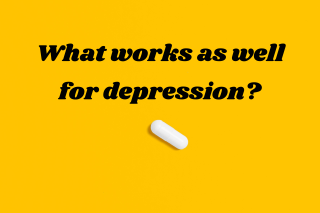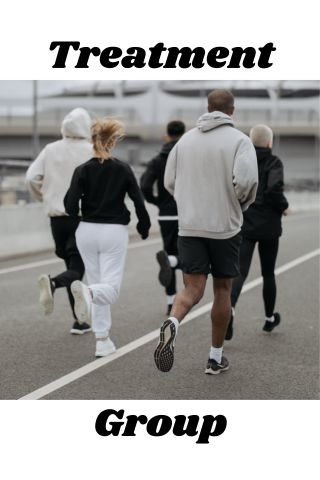
For some, an alternative treatment may be better.
Photo by Anna Shvets on Pexels.
What if I told you there was an alternative to taking antidepressant medications for depression and anxiety that is all natural and highly effective? What if I told you that it avoids many of the negative side effects of antidepressants, and actually has added positive side effects? And what if I told you that the new study supporting it—which I’m about to describe, I promise!—actually isn’t the first to introduce this treatment? It’s actually been studied for a long time—and used for even longer. The problem is that it’s hard to implement, and it isn’t available to everyone. So what is it?
A recently published study had participants in one of two 16-week interventions: either they took an antidepressant medication or they went on two to three 45-minute runs a week. The antidepressant was escitalopram, a commonly prescribed SSRI medication that has a good side effect profile. Dosage was adjusted, as needed, by a psychiatrist who met with the patients throughout the study.
Running sessions were supervised by research staff, and involved a 10-minute warm up, 30 minutes of jogging, and then a 5-minute cool down. The running therapy also involved being assigned a training range for their heart rate, based on a baseline cycling test. Heart rate monitors were worn during the session to ensure patients were within the assigned training range. There were organized exercise group sessions that people were expected to participate in, but they were also allowed to miss these and make up running sessions on their own. Compliance with the running program was defined as making 70% of the expected jogs.
The top line result is that running was just as effective as antidepressants in reducing depression. At the end of the study, 45% of the patients in the antidepressant group and 43% of patients in the running group no longer met criteria for depression or anxiety. Yes, the surprise treatment is going jogging regularly.

Running therapy can have substantial benefits.
Photo from Cottonbro Studios on Pexel.
There were also indications that the running group had some health benefits that antidepressants didn’t. People in the running group had lower systolic and diastolic blood pressure, lower resting heart rate, and higher heart rate variability—all indicators of better physical health. There was also a tendency for patients in the antidepressant group to put on weight, and for those in the running group to lose weight. This got rid of a side effect that many people want to avoid with antidepressants.
If running is so great, then why don’t we just tell everyone to do that instead of taking antidepressants? Here, we come to the downside: 82% of the people assigned to antidepressants actually stuck with them and completed their prescribed course of treatment. Only 52% of the people assigned running therapy stuck with it.
If our priority is actually reducing the number of depressed people in the world, this is a big impediment. We can find that running is really helpful if people participate in long exercise sessions frequently, but for some that can be daunting. The people in this study were specifically chosen for inclusion because they only exercised one day a week (or less). That probably means they have difficulty finding the time in their lives, or that they struggle finding the energy and motivation to exercise. It may also be that some people just don’t like running, but in this study 83 of the 96 people receiving running as a therapy for depression chose it as their preference.
That brings up another limitation to this study: it wasn’t an ordinary randomized controlled trial, where everyone has an equal chance of being assigned to one treatment or another. It also wasn’t like trials comparing, say, two medications, where patients don’t know which treatment they’re getting. Keeping patients in the dark about whether they were running or taking a pill was impossible. Instead, participants were given the option to choose which one to do, or to opt to be randomized into one group or the other. Only 22 of the 141 people included in the study wanted to be randomized—everyone else chose the group they preferred.
In research, randomized assignment where patients are blind to the treatment they’re getting is used to avoid placebo effects. This design didn’t really eliminate this risk. Jog-lovers and pill-lovers alike were given their preference, so part of the effect we were seeing might have been related to feeling better about getting their personal preferences met. On the other hand, getting to choose your treatment also better reflects care in the real world. So these estimates are relevant to real-world outcomes.
There’s also the issue of who is able to participate in a running therapy program. This treatment won’t be available to people who don’t have the full use of their legs, or might have other physical limitations on their ability to do 45 minutes of exercise. It’s possible that alternatives to jogging—maybe a cardio exercise that relies more on arms, like a rowing machine—could provide similar benefits. However, that wasn’t addressed by this study.

Running therapy may not work for everyone.
Photo from Pixabay on Pexels.
Finally, I’ve known plenty of people who exercise regularly and are still depressed. In that case, a person might not get the big benefit seen here by someone who just started exercise. A combination of treatments–running plus antidepressants, for example—might be needed.
In the discussion, the authors of this study suggest that this research could become part of a broader body of work that addresses specific subsets of patients for whom running therapy might be a good prescription. For example, their literature review suggests that running therapy might be particularly useful for patients with high inflammation levels and not as useful for patients with certain kinds of metabolic problems, like insulin resistance. This new study isn’t able to make these kinds of recommendations, but it does push the needle forward by monitoring a mix of physical and mental health symptoms. (I didn’t even mention many of the physical indicators—like triglycerides and C-reactive protein—that were monitored!) This kind of comprehensive psychological and physical examination points the way for choosing a more individualized treatment. As we begin to take mind-body connections more seriously in identifying subtypes of depression, we may be able to better choose what treatment will help a particular individual most.
Bottom line: if you’re depressed, don’t immediately drop your antidepressant and start going on 45-minute jogs. But do consider bringing it up with your medical provider—or just staying on your current treatment and adding some regular jogs into the mix. The evidence suggests it will help!
